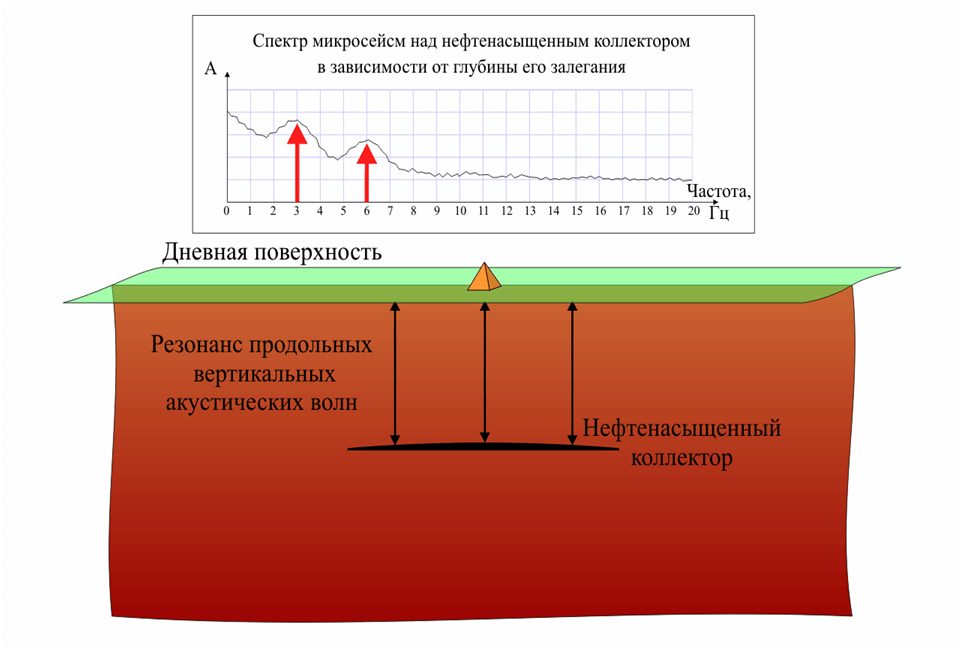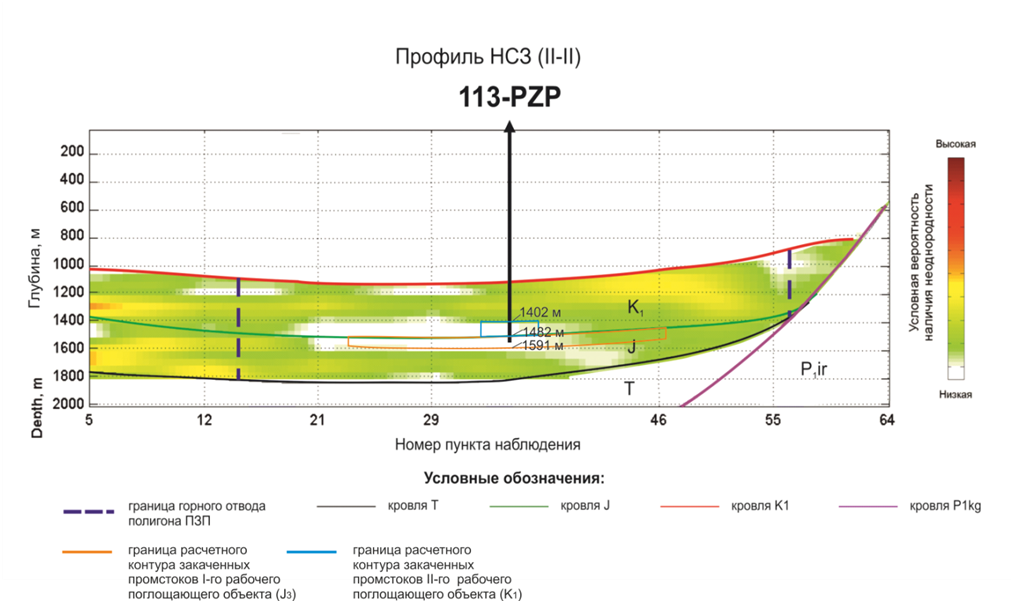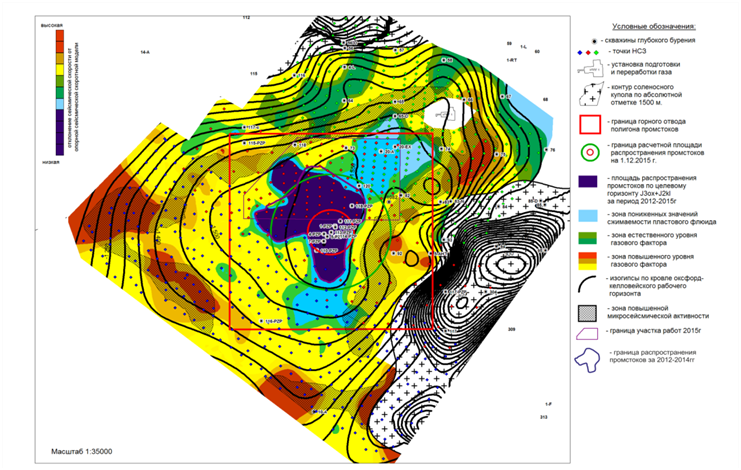
Russia. Astrakhan
Prospect Gub. A. Guzhvin, 10 "A"
Prospect Gub. A. Guzhvin, 10 "A"

+7 (8512) 484-444
On weekdays from 8:00 to 17:00The LFS method is based on the study of the spectral characteristics of natural acoustic fields in the frequency range of 0.5-10 Hz.
Physical principles of the method.
Continuous excitation of the Earth's crust by atmospheric, oceanic (tides, surf, water friction against the ocean floor) and other influences leads to the formation of low-frequency standing waves.
The latter are formed at various nonuniformitiesin the thickness of the sedimentary cover, and are characterized by a constant frequency and amplitude for each of such nonuniformities(Fig. 1).

Figure 1. Scheme of standing wave formation from nonuniformityin the form of an oil deposit. The figure shows that, depending on the depth of the deposit, the amplitude-frequency spectrum of the standing wave changes
Registered natural acoustic fields contain in addition to standing waves, various other types of waves (Rayleigh, Love, etc.) which are for the LFS method interference.
Against the background of interference waves, standing waves are characterized by a more consistent and pronounced amplitude-frequency spectrum due to the phenomenon of resonance. The resonance effect is caused by the fact that the geological environment between the acoustically contrast inhomogeneity and the earth's surface is a kind of resonator.
To distinguish standing waves against the background of a natural acoustic field, a method based on the construction of synthetic models of standing waves is used. The construction of such a model is based on the geological model of the background medium, within which the search object is specified.
During the simulation, the parameters of the search object are searched: the location of the search object, its geometric dimensions and elastic parameters.As a search object, the hydrocarbon reservoir or another object with counter properties can be specified that differ sharply from the background medium.
Based on the simulation results, the obtained model spectrum (amplitude-frequency) of the standing wave is compared with the registered spectrum of the natural acoustic field of standing waves (after removal of the noise components).
When the model spectrum coincides with the observed spectrum of the standing wave, a decision to allocate a search object with given parameters is made.
The capabilities of the LFS method can be used to solve a wide range of tasks both at the stage of geological exploration (GЕ) and technological tasks at the stage of field development.
The tasks to be performed by the LFS in the stages of the geological survey
Since the hydrocarbon-saturated reservoir has a high acoustic contrast with respect to the constituents of the geological section
rocks, the LFS method can be used to identify anomalies associated with the presence of hydrocarbons in the collector layer at all stages and stages of geological exploration, including:
At the exploratory and evaluation stage, LFS studies aimed at:
- Ranking of territories for the perspectives of oil and gas potential;
- Defining the boundaries of gas-water surface, oil-water surface;
- Mapping the boundaries of structural and non-structural type hydrocarbons aggregates in plan and in section;
- mapping of zones without collectors;
- issuing recommendations on the location of wells for drilling.
At the stage of exploration and additional exploration, conducted works of the LFS are aimed at:
- detailed mapping of individual accumulations of hydrocarbons above and below the reservoir;
- mapping of hydrocarbon accumulations framing the main deposit, including the non-structural type.
The tasks to be solved by the LFS at the stage of development and abandonment of the field.
In the construction of wells there is a violation of the natural disconnection of the horizons that make up the geological section. In the process of developing deposits, changes occur in the stress-strain state of the geological section.
As a result of these processes, subvertical, multidirectional fluid migration channels occur that fill subhorizontal reservoirs in collector layers.
The development of fluid migration processes leads to a decrease in the balance reserves of hydrocarbons, dilution of reserves. The likely yield of fluids on the day surface entails the emergence of emergency situations, down to catastrophic.
"Octopus" JSC is a pioneer in the use of passive microseismic methods, in particular, LFS for solving technological problems facing the subsoil user at all stages of the life cycle of the field, including:
- mapping of hydrocarbon accumulations outside the productive horizon;
- monitoring of man-made and natural accumulations of hydrocarbons;
- monitoring the integrity of underground facilities, such as mine workings, including:
- UGSF;
- production wells;
- wells having complications (tool failure) along the trunk;
- abandoned wells;
- other objects;
- monitoring the distribution of injected wastes;
- Identification of nonuniformitieswith anomalgeomechanical properties in the sedimentary cover.
Experience in performing work by the LFS method
The Octopus company performed works by the LFS method on a number of fields in Western Siberia (Urengoy, Yamburg, Noyabrsk, Nadym), Astrakhan Region, Irkutsk Region and Kamchatka.
The total number of objects of research of the LFS under concluded contracts for 2016 amounted to 36 objects.
Here are some results of the work performed by the LFS method:
Work in the Purovsky District of the Yamal-Nenets Autonomous District of Russia to identify zones of formation of man-made accumulations. 2016 year
In the course of the work the following was carried out:
- Investigation of interwell space, not controlled by GIS methods, for the detection of technogenic accumulations of hydrocarbons;
- determination of the presence of fluid saturation below the bottom of the well
Figure 2 shows an example of a section of the LFS passing through one of the investigated wells.

Fig.2. Results of study of borehole environment using LFS method
As can be seen from the figure, the deposits below the bottom of the well clearly appear, associated with the Neocomian and Achimov deposits. A distinctive anomaly is the Cenomanian reservoir.
According to the GIS, in the interval 839-1560 there were marked cesspools.
In the field of the NHS, distinct anomalies are observed in the intervals 450-550 m, 750-850 m, 1300-1400 m. Anomalies above the Cenomanian deposit do not contact the wellbore and are possibly associated with natural gas-saturated layers.
The anomaly at a depth of 1300-1400 is probably associated with the penetration of fluid into the layer. However, this anomaly can be associated with a thin gas-bearing inter-layer initially. In this regard, it is recommended to perform a second measurement after 1 year, in order to clarify the nature of the anomalies obtained.
Monitoring of injection of industrial waste
On the territory of the Astrakhan region, work to monitor the injection of industrial effluents into the horizons of the Jurassic deposits was carried out.
Studies on the movement of industrial waste were conducted in 2012-2014.
Based on the results of the research, the zones of distribution of industrial wastes (washed zone) were identified, as well as the zone of mixing of formation and injected waters.

Based on the results of work in 2014, a scheme was proposed for monitoring the area of industrial waste in the most dangerous areas annually.

In 2015, the distribution of industrial wastes was monitored in the northeastern part of the injection site.
According to the results of monitoring in 2015, it was revealed:
- the distribution of industrial waste in the expected most dangerous north-eastern direction was not confirmed.
- it was revealed that a new direction of the advance of the industrial front - north-west. The length of the advance was 520 m.
In 2016, during the construction of one of the wells in the northeastern direction, troubles were recorded during construction. When analyzing the samples of the selected fluid, industrial wastes were found in its composition. This confirmed the conclusion that the zone monitored by the monitoring zone is indeed a mixing zone. That this zone is potentially dangerous and its distribution should also be monitored.
Since the advance of the industrial waste front occurs in different directions, the volume and frequency of the monitoring work have been corrected.
The next works on monitoring the distribution of industrial waste are scheduled for 2017. The work is planned to be carried out on a uniform grid of 250x250 oriented from north to south, with an output beyond the boundaries of the mining allotment by 2 ft. of observation. With a frequency of once every 2 years.

Determination of the boundary of the zone of regional absence of reservoirs. Irkutsk Region, 2015

On the vertical profile, a productive reservoir of the Parfenovhorizon is well distinguished in the form of a bright anomaly (recording station (r.s.) 1-19), betweenr.s. 19-20, the anomaly abruptly breaks off and further a zone with extremely low gas-bearing prospects is located. Anomalies of low intensity (white color) are noted in the region of r.s. 20, 28 and 34, and are associated with the presence in the Parfenov horizon of single low-power collectors with non-economic gas reserves.
Above the cut at the level of the Christophor and Balytyn horizons, an anomaly associated with the possible gas saturation of the collector is noted.
In the Lower Angara sub-suite in the vicinity of 22 and 23, an anomaly is identified that may be associated with the gas saturation of the reservoir or the AHRP zone.
An example of determining the hydrocarbons saturation of a geological section at a field in the Kamchatka Region in 2013-2014.

